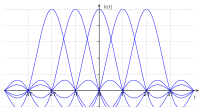
Photo from wikipedia
Multiple-input and multiple-output synthetic aperture radar (MIMO SAR) is a very potential technique for high-resolution and wide-swath (HRWS) imaging due to the fact that it can provide more degrees of… Click to show full abstract
Multiple-input and multiple-output synthetic aperture radar (MIMO SAR) is a very potential technique for high-resolution and wide-swath (HRWS) imaging due to the fact that it can provide more degrees of freedom. In this article, an innovative MIMO-HRWS SAR imaging system is introduced with segmented phase coding (SPC) waveforms. However, it is well-known that the echo separation issue is the most technical challenge for MIMO SAR. It has shown that the separation of orthogonal echoes from cross correlation interference can be achieved by scan-on-receive (SCORE). However, this method often requires large computing resources on board, especially for null-steering process. For this, we propose a two-stage spaceborne–ground echo separation scheme. This scheme is mainly divided into two steps: the first step is a real-time SCORE beamforming process on board to reduce the downlink data volume, and the second step is a bandpass–null-steering process to suppress the interfering echoes on the ground. Thus, this scheme allows for the low computing resources on board and sufficient suppression of the interference simultaneously. Following this scheme, the MIMO-HRWS SAR system enables its number of equivalent phase centers nearly double that of the azimuth multichannel SAR system, leading to higher resolution and wider swath imaging. Finally, detailed simulation experiments for the MIMO-HRWS SAR imaging system are performed to verify the practicability and feasibility of the proposed scheme.
Journal Title: IEEE Transactions on Geoscience and Remote Sensing
Year Published: 2022
Link to full text (if available)
Share on Social Media: Sign Up to like & get
recommendations!